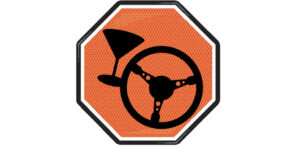Federal Funding to Support Safety
Roadway safety advocates discuss the importance of partnerships with federal agencies
Standards, Education and Awareness
Adrienne Gildea, Deputy Executive Director of the Commercial Vehicle Safety Alliance (CVSA)
The CVSA started as a technical standard-setting organization focused on standardizing and unifying the North American Standard Inspection Program to advance our shared goal of reducing crashes and fatalities. Some of this is very technical work to make sure that nothing on the truck presents an imminent hazard. We also work on the policy side with the Federal Motor Carriers Safety Administration (FMCSA), members of Congress and folks in the industry—even looking ahead to what the world of autonomous trucks is going to look like. So, we’ve grown from a very technical or professional, standard-setting organization to one of the leaders on trucking and bus safety in the U.S., Canada and Mexico. We also have some initiatives with the Federal Highway Administration.
We are a grant recipient and contractor for the FMCSA, and we use grant funds to help supplement and fund several of our initiatives. For example, we have a contract with FMCSA for a fatigue management program. Other initiatives are more focused on enforcing commercial motor vehicle-specific laws and regulations. We have a couple of campaigns that focus on vehicle safety, including Brake Safety Week, which is usually in the summer. That’s when we distribute inspection forms to the jurisdictions and ask them to collect data on brake violations. And at the same time, we try to raise awareness about proper brake maintenance and care so that we see fewer incidents caused by brake deficiencies. Statistically, we find that brake violations are one of the leading violations on the roadway when you pull the data. Obviously, the brakes are a critical component of vehicle safety because they determine whether a crash occurs or not.
Another of the initiatives that we are partnering with FMCSA on is an awareness campaign focused on the prevention and detection of human trafficking. We’ve partnered with Truckers Against Trafficking and are helping to distribute their window stickers and wallet cards that help folks who might come across a victim of human trafficking on the roads to recognize the signs. We are helping to teach drivers how to respond and how they can safely and compassionately help that person. We were focusing on that in January in the U.S., February in Canada, and March in Mexico. Our efforts dovetail with the national human trafficking awareness campaigns in the U.S. and Canada, so we sent out educational training and brochures to the jurisdictions to help them get better prepared to really focus on this issue during the three-day campaign.
From Highways to Crosswalks
Greg Cohen, Director, Roadway Safety Foundation
Our organization works with the Federal Highway Administration (FHWA) to focus on engineering solutions for the roads and the environment around the roads. We have a five-year cooperative agreement with FHWA; it’s not a contract, so we have some flexibility in what we do. The most well-known of our programs is the biennial National Roadway Safety Awards, which involves collecting information about various projects and programs around the country that are innovative and have data-driven metrics to show how they’ve reduced deaths and injuries. We put together a blue-ribbon panel to determine the awardees and send their results around the country—to both communities and to engineering agencies so that they can learn from the successes of others.
We also put together the Roadway Safety Guide, which is a community toolkit about how communities can get involved in roadway safety efforts by working with their local transportation departments or city councils to find federal money or other funds to fix problems. We also have a major project that is part of an international program called the U.S. Road Assessment Program, which is an engineering evaluation of highways and streets through snapshots taken every 100 meters. The relative safety of the roads is then rated on a one- to five-star scale. So, we’re implementing that on roads all over the country, but it’s also part of a worldwide effort to get roads up to at least a three-star standard or better. There are about 70 factors that go into each photograph to determine its star rating, but the program also allows planning agencies to put out a report based on any sort of budget of what recommended improvements should be looked at and their potential cost and benefit. The FHWA’s funding helps us pay for that, particularly for local and tribal communities that would not be able to pay for that work on their own.
Other projects that we’ve done most recently are pedestrian safety campaigns with the FHWA. One is an educational campaign that’s gone out on television, and the other are related to two new technologies. One of those is Rectangular Rapid Flashing Beacons, which are signs posted at mid-block crosswalks with flashing rectangular LED lights that are activated by the pedestrian. There is also new funding for Pedestrian Hybrid Beacons. They feature a combination of a yellow light and two red lights that are also activated by the pedestrian or bicyclist at a mid-block or low-use crossing.
There’s always changing technology and science in terms of the quality of signs and the colors that are used. For example, more than 10 years ago, school crossings signs were approved to have a different color than regular crossings. The new signs are more of a fluorescent yellow-green than the old yellow signs. We rely on the federal cooperative agreement for most of our programs, and unlike others, who are concerned with vehicles or driver behavior, The Roadway Safety Foundation focuses on the road itself.
One thing that we are careful about is to make sure we’re not becoming an advocacy group for specific companies, some of which are members of our group. We’ve had guardrail companies [as members], and we’ve advocated for cable median barrier systems, which are not produced by either of those companies. We try to keep it from being too focused on any particular member, but they have a valuable contribution to make because a lot of times they’re ahead of the curve and ahead of the government in terms of what’s going to come out next—the new thing that will keep the car on the road or make the vehicle itself recognize a pedestrian, so we’re getting into that space more.
We all work together because we all see that there is a benefit in taking a more holistic approach, by improving on the road itself, the user, adequate post-crash care, the safety of the vehicle and speed management. But we need individual groups to focus on each of those things to make sure that attention is given to the areas of their specialty.




